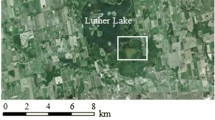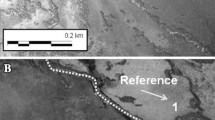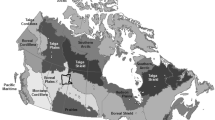Abstract
Peatlands are characterized by their large carbon (C) storage capacity and represent important C sinks globally. In southern Chile, young peatlands (few centuries old) have originated due to clearcutting or fire at forest sites with high precipitation on poorly drained soils. These novel ecosystems are called anthropogenic peatlands here. Their role in the regional C cycle remains largely unknown. Here, we present 18 months of eddy covariance measurements of net ecosystem exchange (NEE) of carbon dioxide (CO2) in an anthropogenic peatland in northern Chiloé Island, part of which is kept undisturbed for 30–40 years, by excluding human uses, and another section of the same peatland that has been disturbed by cattle grazing and Sphagnum moss extraction. Gross primary productivity (GPP) and ecosystem respiration (Reco) were modeled from NEE, based on measured photosynthetically active radiation and air temperature, separately for each section of the peatland. Uncertainties of the annual flux estimates were assessed from the variability of modelled fluxes induced by applying different time-windows for model development between 10 and 20 days. The undisturbed area of the peatland was on average (± SD) a larger net CO2 sink (NEE = − 135 ± 267 g CO2 m−2 year−1) than the disturbed area (NEE = − 33 ± 111 g CO2 m−2 year−1). These NEE CO2 balances are small even though GPP and Reco were larger compared with other peatlands. Reco had a direct relationship with water table depth (from soil surface) and a negative relationship with soil water fraction. Our results show that the disturbance by moss extraction and cattle grazing is likely to reduce the CO2 sink function of many anthropogenic and natural peatlands on Chiloé Island, which are subjected to the same impacts.







Similar content being viewed by others
References
Aravena JC, Carmona MR, Pérez CA, Armesto JJ (2002) Changes in tree species richness, stand structure and soil properties in a successional chronosequence in northern Chiloé Island, Chile. Rev Chil Hist Nat 75:339–360. https://doi.org/10.4067/S0716-078X2002000200007
Aslan-Sungur G, Lee X, Evrendilek F, Karakaya N (2016) Large interannual variability in net ecosystem carbon dioxide exchange of a disturbed temperate peatland. Sci Total Environ 554:192–202. https://doi.org/10.1016/j.scitotenv.2016.02.153
Aubinet M, Vesala T, Papale D (eds) (2012) Eddy covariance: a practical guide to measurement and data analysis. Springer, New York
Aurela M, Touvinen JP, Laurilla T (1998) Carbon dioxide exchange in a subartic peatland ecosystem in northern Europe measured by eddy covariance technique. J Geophys Res 103:289–301. https://doi.org/10.1029/98JD00481
Bridgham SD, Pastor J, Dewey B, Weltzin JK, Updegraff K (2008) Rapid carbon response of peatlands to climate change. Ecology 89:3041–3048. https://doi.org/10.1890/08-0279.1
Bullock A, Acreman M (2003) The role of wetlands in the hydrological cycle. Hydrol Earth Syst Sc 7:358–389. https://doi.org/10.5194/hess-7-358-2003
Cabezas J, Galleguillos M, Valdés A, Fuentes JP, Pérez C, Pérez-Quezada JF (2015) Evaluation of impacts of management in an anthropogenic peatland using field and remote sensing data. Ecosphere 6:282. https://doi.org/10.1890/ES15-00232.1
Cabré MF, Solman S, Núñez M (2016) Regional climate change scenarios over southern South America for future climate (2080–2099) using the MM5 model. Mean, interannual variability and uncertainties. Atmósfera 29:35–60. https://doi.org/10.20937/ATM.2016.29.01.04
Carmona MR, Aravena JC, Bustamante-Sánchez MA, Celis-Diez JL, Charrier A (2010) Estación Biológica Senda Darwin: investigación ecológica de largo plazo en la interfase ciencia-sociedad. Rev Chil Hist Nat 83:113–142. https://doi.org/10.4067/S0716-078X2010000100007
Chapin FS, Woodwell GM, Randerson JT, Lovett GM, Rastetter EB, Baldocchi DD, Clark DA, Harmon ME, Schimel DS, Valentini R, Wirth C, Aber JD, Cole JJ, Goulden ML, Harden JW, Heimann M, Howarth RW, Matson PA, McGuire AD, Melillo JM, Mooney HA, Neff JC, Houghton RA, Pace ML, Ryan MG, Running SW, Sala OE, Schlesinger WH, Schulze ED (2006) Reconciling carbon-cycle concepts, terminology, and methods. Ecosystems 9:1041. https://doi.org/10.1007/s10021-005-0105-7
Christensen RT, Jackowicz-Korczyński M, Aurela M, Crill P, Heliasz M, Mastepanov M, Friborg T (2012) Monitoring the multi-year carbon balance of a subarctic Palsa mire with micrometeorological techniques. Ambio 41:207–217. https://doi.org/10.1007/s13280-012-0302-5
Cleveland WS (1979) Robust locally weighted regression and smoothing scatterplots. J Am Stat Assoc 74:829–836. https://doi.org/10.1080/01621459.1979.10481038
Clymo RS (1984) The limits to peat bog growth. Philos T Roy Soc B 303:605–654
CONAF-CONAMA (1999) Catastro y evaluación de recursos vegetacionales nativos de Chile. Informe Nacional con Variables Ambientales, Santiago
D’Acunha B (2017) Net ecosystem carbon balance for a peat bog undergoing restoration by integrating flux tower and aquatic flux measurements. Master Thesis. University of British Columbia, Vancouver, Canada
Dec D, Zúniga F, Thiers O, Paulino L, Valle S, Villagra V, Tadich I, Horn R, Dörner J (2017) Water and temperature dynamics of aquands under different uses in southern Chile. J Soil Sci Plant Nut 17:141–154. https://doi.org/10.4067/S0718-95162017005000011
Di Castri F, Hajek E (1976) Bioclimatología de Chile. Vicerrectoría Académica, Universidad Católica de Chile, Santiago
Díaz MF, Armesto JJ (2007) Limitantes físicos y bióticos de la regeneración arbórea en matorrales sucesionales de la Isla Grande de Chiloé, Chile. Rev Chil Hist Nat 80:13–26. https://doi.org/10.4067/S0716-078X2007000100002
Díaz MF, Larraín J, Zegers G, Tapia C (2008) Caracterización florística e hidrológica de turberas de la Isla Grande de Chiloé, Chile. Rev Chil Hist Nat 81:455–468. https://doi.org/10.4067/S0716-078X2008000400002
Díaz MF, Tapia C, Jiménez P, Bacigalupe L (2012) Sphagnum magellanicum growth and productivity in Chilean anthropogenic peatlands. Rev Chil Hist Nat 85:513–518. https://doi.org/10.4067/S0716-078X2012000400013
Forbrich I, Kutzbach L, Wille C, Becker T, Wu J, Wilmking M (2011) Cross-evaluation of measurements of peatland methane emissions on microform and ecosystem scales using high-resolution landcover classification and source weight modelling. Agric Forest Meteorol 151:864–874. https://doi.org/10.1016/j.agrformet.2011.02.006
Fortuniak K, Pawlak W, Bednorz L, Grygoruk M, Siedlecki M, Zieliński M (2017) Methane and carbon dioxide fluxes of a temperate mire in Central Europe. Agric For Meteorol 232:306–318. https://doi.org/10.1016/j.agrformet.2016.08.023
Hedin LO, Armesto JJ, Johnson AH (1995) Patterns of nutrient loss from unpolluted old growth temperate forests: evaluation of biogeochemical theory. Ecology 76:493–509
Helfter C, Campbell C, Dinsmore KJ, Drewer J, Coyle M, Anderson M, Skiba U, Nemitz E, Billett MF, Sutton MA (2015) Drivers of long-term variability in CO2 net ecosystem exchange in a temperate peatland. Biogeosciences 12:1799–1811. https://doi.org/10.5194/bg-12-1799-2015
Hendriks DMD, Van Huissteden J, Dolman AJ, Van Der Molen MK (2007) The full greenhouse gas balance of an abandoned peat meadow. Biogeosciences 4:411–424. https://doi.org/10.5194/bg-4-411-2007
Holl D, Pancotto V, Heger A, Camargo SJ, Kutzbach L (2019) Cushion bogs are stronger carbon dioxide net sinks than moss-dominated bogs as revealed by eddy covariance measurements on Tierra del Fuego, Argentina. Biogeosciences. https://doi.org/10.5194/bg-2019-156
Hooijer A, Page S, Canadell JG, Silvius M, Kwadijk J, Wosten H, Jauhiainen J (2010) Current and future CO2 emissions from drained peatlands in Southeast Asia. Biogeoscience 7:1505–1514. https://doi.org/10.5194/bg-7-1505-2010
Humphreys ER, Lafleur PM, Flanagan LB, Hedstrom N, Syed KH, Glenn AJ, Granger R (2006) Summer carbon dioxide and water vapor fluxes across a range of northern peatlands. J Geophys Res 111:G04011. https://doi.org/10.1029/2005JG000111
Intergovernmental Panel on Climate Change (IPCC) (2013) Summary for policymakers. In: Stocker TF, Qin D, Plattner GK, Tignor M, Allen SK, Boschung J, Nauels A, Xia Y, Bex V, Midgley PM (eds) Climate change 2013: the physical science basis. Contribution of working group i to the fifth assessment report of the intergovernmental panel on climate change. Cambridge University Press, Cambridge and New York
Juszczak R, Humphreys E, Acosta M, Michalak-Galczewska M, Kayzer D, Olejnik J (2013) Ecosystem respiration in a heterogeneous temperate peatland and its sensitivity to peat temperature and water table depth. Plant Soil 366:505–520. https://doi.org/10.1007/s11104-012-1441-y
Kormann R, Meixner FX (2001) An analytical footprint model for non-neutral stratification. Bound Layer Meteorol 99:207–224. https://doi.org/10.1023/A:1018991015119
Lafleur PM, Roulet NT, Bubier JL, Frolking S, Moore TR (2003) Interannual variability in the peatland-atmosphere carbon dioxide exchange at an ombrotrophic bog. Glob Biogeochem Cycle 17:1036. https://doi.org/10.1029/2002GB001983
Lafleur PM, Moore TR, Roulet NT, Frolking S (2005) Ecosystem respiration in a cool temperate bog depends on peat temperature but not water table. Ecosystems 8:619–629. https://doi.org/10.1007/s10021-003-0131-2
Limpens J, Berendse F, Blodau C, Canadell JG, Freeman C, Holden J, Roulet N, Rydin H, Schaepman-Strub G (2008) Peatlands and the carbon cycle: from local processes to global implications: a synthesis. Biogeosciences 5:1475–1491. https://doi.org/10.5194/bg-5-1475-2008
Lund M, Christensen TR, Lindroth A, Schubert P (2012) Effects of drought conditions on the carbon dioxide dynamics in a temperate peatland. Environ Res Lett 7:045704. https://doi.org/10.1088/1748-9326/7/4/045704
Lund M, Bjerke JW, Drake BG, Engelsen O, Hansen GH, Parmentier FJW, Powell TL, Silvennoinen H, Sottocornola M, Tommervik H, Weldon S, Rasse DP (2015) Low impact of dry conditions on the CO2 exchange of a Northern-Norwegian blanket bog. Environ Res Lett 10:025004. https://doi.org/10.1088/1748-9326/10/2/025004
McVeigh P, Sottocornola M, Foley N, Leahy P, Kiely G (2014) Meteorological and functional response partitioning to explain interannual variability of CO2 exchange at an Irish Atlantic blanket bog. Agric For Meteorol 194:8–19. https://doi.org/10.1016/j.agrformet.2014.01.017
Nykänen H, Alm J, Silvola J, Tolonen K, Martikainen PJ (1998) Methane fluxes on boreal peatlands of different fertility and the effect of long-term experimental lowering of the water table on flux rates. Glob Biogeochem Cycle 12:53–69. https://doi.org/10.1029/97GB02732
Page SE, Baird AJ (2016) Peatlands and global change: response and resilience. Annu Rev Environ Resour 41:35–57. https://doi.org/10.1146/annurev-environ-110615-085520
Page SE, Rieley JO, Banks CJ (2011) Global and regional importance of the tropical peatland carbon pool. Glob Change Biol 17:798–818. https://doi.org/10.1111/j.1365-2486.2010.02279.x
Peichl M, Öquist M, Löfvenius MO, Ilstedt U, Sagerfors J, Grelle A, Lindroth A, Nilsson MB (2014) A 12-year record reveals pre-growing season temperature and water table level threshold effects on the net carbon dioxide exchange in a boreal fen. Environ Res Lett 9(5):055006
Peichl M, Gazovic M, Vermeij I, De Goede E, Sonnentag O, Limpens J, Nilsson MB (2018) Peatland vegetation composition and phenology drive the seasonal trajectory of maximum gross primary production. Sci Rep 8:8012. https://doi.org/10.1038/s41598-018-26147-4
Perez-Quezada JF, Celis-Diez JL, Brito CE, Gaxiola A, Nunez-Avila M, Pugnaire FI, Armesto JJ (2018) Carbon fluxes from a temperate rainforest site in southern South America reveal a very sensitive sink. Ecosphere 9:e02193. https://doi.org/10.1002/ecs2.2193
RAMSAR (2013) The Ramsar convention manual: a guide to the convention on wetlands (Ramsar, Iran, 1971), 6th edn. Ramsar Convention Secretariat, Gland
Rankin T, Strachan IB, Strack M (2018) Carbon dioxide and methane exchange at a post-extraction, unrestored peatland. Ecol Eng 122:241–251
Renou-Wilson F, Moser G, Fallon D, Farrell CA, Müller C, Wilson D (2019) Rewetting degraded peatlands for climate and biodiversity benefits: results from two raised bogs. Ecol Eng 127:547–560. https://doi.org/10.1016/j.ecoleng.2018.02.014
Richardson R (2011) Catastro de turberas productoras de musgo en la Región los Lagos. Estudios Hemisféricos Polares 2:249–266
Rößger N, Wille C, Holl D, Göckede M, Kutzbach L (2019) Scaling and balancing carbon dioxide fluxes in a heterogeneous tundra ecosystem of the Lena River Delta. Biogeosciences 16:2591–2615. https://doi.org/10.5194/bg-16-2591-2019
Runkle B, Sachs T, Wille C, Pfeiffer EM, Kutzbach L (2013) Bulk partitioning the growing season net ecosystem exchange of CO2 in Siberian tundra reveals the seasonality of its carbon sequestration strength. Biogeosciences 10:1337–1349
Schlatter RP, Schlatter JE (2004) Los turbales de Chile. In: Blanco DE, Balze VM (eds) Los Turbales de la Patagonia. Bases para su inventario y la conservación de su biodiversidad, Publicación No. 19. Wetlands International - América del Sur, Buenos Aires, pp 75–80
Silva W (2016) Resilient response of Sphagnum litter decay to experimental warming in northern Chiloé Island, southern Chile. Master Thesis, Facultad de Ciencias, Universidad de Chile
Tian H, Lu C, Yang J, Banger K, Huntzinger DN, Schwalm CR, Michalak AM, Cook R, Ciais P, Hayes D, Huang M, Ito A, Jain AK, Lei H, Mao J, Pan S, Post WM, Peng S, Poulter B, Ren W, Ricciuto D, Schaefer K, Shi X, Tao B, Wang W, Wei Y, Yang Q, Zhang B, Zeng N (2015) Global patterns and controls of soil organic carbon dynamics as simulated by multiple terrestrial biosphere models: current status and future directions. Glob Biogeochem Cycle 29:775–792. https://doi.org/10.1002/2014GB005021
Tuovinen JP, Aurela M, Hatakka J, Räsänen A, Virtanen T, Mikola J, Ivakhov V, Kondratyev V, Laurila T (2019) Interpreting eddy covariance data from heterogeneous Siberian tundra: land-cover-specific methane fluxes and spatial representativeness. Biogeosciences 16:255–274. https://doi.org/10.5194/bg-16-255-2019
United States Department of Agriculture (USDA) (2014) Keys to soil taxonomy, 12th edn. USDA-Natural Resources Conservation Service, Washington, DC
Van Breemen N (1995) How sphagnum bogs down other plants. Trends Ecol Evol 10:270–275. https://doi.org/10.1016/0169-5347(95)90007-1
Veblen TH, Donoso C, Kitzberger TH, Robertus A (1996) Ecology of southern Chilean and Argentinean Nothofagus forest. In: Veblen TH, Hill RS, Read J (eds) The ecology and biogeography of Nothofagus forests, vol 10. Yale University Press, London, pp 93–353
Vitt DH (2006) Functional characteristics and indicators of boreal peatlands. In: Wieder RK, Vitt DH (eds) Boreal peatland ecosystems. Ecological studies, vol 188. Springer, New York, pp 9–24
Waddington JM, Strack M, Greenwood MJ (2010) Toward restoring the net carbon sink function of degraded peatlands: short-term response in CO2 exchange to ecosystem-scale restoration. J Geophys Res 115:G01008. https://doi.org/10.1029/2009JG001090
Waddington J, Morris P, Kettridge N, Granath G, Thompson D, Moore P (2014) Hydrological feedbacks in northern peatlands. Ecohydrology 8:113–127. https://doi.org/10.1002/eco.1493
Xu J, Morris PJ, Liu J, Holden J (2018) PEATMAP: refining estimates of global peatland distribution based on a meta-analysis. CATENA 160:134–140. https://doi.org/10.1016/j.catena.2017.09.010
Yu Z (2012) Northern peatland carbon stocks and dynamics: a review. Biogeosciences 9:4071–4085. https://doi.org/10.5194/bg-9-4071-2012
Acknowledgements
Authors are grateful to W. Silva for assisting with fieldwork and equipment maintenance. This is a contribution to the Research Program of Senda Darwin Biological Station and the Chilean Long-Term Socio-Ecological Research Network (LTSER-Chile), affiliated with ILTER, AMERIFLUX, and FLUXNET. JLC-D is an affiliated researcher with IEB.
Funding
This study was funded by the National Commission for Scientific and Technological Research (CONICYT, Chile) through the Grant FONDEQUIP AIC-37 to the Instituto de Ecología y Biodiversidad (IEB), FONDECYT N° 1171239 to JFP-Q, Advanced Human Capital Project CONICYT-PCHA/National Doctorate/2013-21130965 to AV-B and PFB-23 to JJA. Partial funding was provided by Grant AFB170008 from the Associative Research Program, CONICYT, Chile. Fieldwork of Lars Kutzbach on Chiloé Island was supported through the Cluster of Excellence CliSAP (EXC177), Universität Hamburg, funded through the German Science Foundation. Additional funding was provided by Iniciativa Científica Milenio (Grant No. P05-002).
Author information
Authors and Affiliations
Corresponding author
Additional information
Publisher's Note
Springer Nature remains neutral with regard to jurisdictional claims in published maps and institutional affiliations.
Rights and permissions
About this article
Cite this article
Valdés-Barrera, A., Kutzbach, L., Celis-Diez, J.L. et al. Effects of disturbance on the carbon dioxide balance of an anthropogenic peatland in northern Patagonia. Wetlands Ecol Manage 27, 635–650 (2019). https://doi.org/10.1007/s11273-019-09682-3
Received:
Accepted:
Published:
Issue Date:
DOI: https://doi.org/10.1007/s11273-019-09682-3




